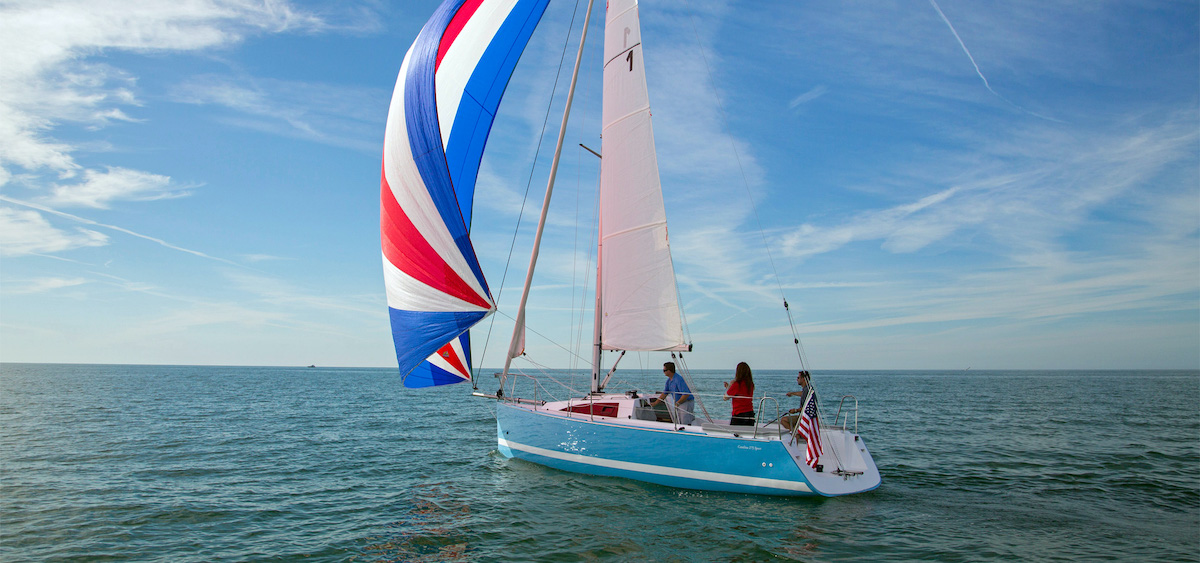You can learn to sail on any sailboat, but small boats are better teachers because they react quickly to crew weight shifts, wind shifts, and every command on the tiller or wheel. This immediate feedback is a valuable tool for new sailors. In fact, it's usually easy to spot sailors who started on smaller tiller–driven boats rather than on large steering wheel boats. This is because they're more in tune with the boat and their surroundings.
There are several classic trainers used by yacht club youth programs as well as new designs. Here are factors to look for in good teaching boats.
Some of the best small sailboats for beginners include:
- Boats with tillers steering
- Boats without winches
- Sailing dinghies
- Small sloops
- Small catamarans
- Rotomolded boats
- Trailerable sailboats
What are the Best Beginner Sailboats?
1. Boats with Tiller Steering
Steering by tiller (rather than a wheel) can make a difference when learning. Tillers directly connect to the rudder, which manages the boat's direction.
Tillers provide quick feedback about the strength and direction of the wind as well as the boat's turning agility at various speeds.
2. Boats Without Winches
Boats that require no winches to manage the sheets and halyards are best for youngsters and new sailors. These boats usually don't experience the same forces on the sails and rigging as larger boats, which can be a handful when the wind starts to blow. Winches are usually replaced with cam or jam cleats, which are easy to use.
3. Sailing Dinghies
Sailing dinghies are usually rigged with one mast and one sail and offer new sailors simplicity, so it's easy to learn the ropes.
Less overwhelming than boats with two sails, dinghies are light and responsive. They also have a shallow draft due to side or centerboards so that they can be sailed just about anywhere.
In some cases (whether from a wind gust or sudden crew weight shift), sailing dinghies can capsize. Due to this, students should wear life jackets and know how to swim. Sailing dinghies are usually sailed by one or two people.
4. Small Sloops
Small sloops with a mast that carries head and mainsails are the next step, so students learn how sails work together. Headsails can be attached to a small roller furler. These boats may have some or no winches, which also makes them easier to maintain. These boats can usually be sailed with one to four people.
Some sloops can scale up, providing a more challenging experience for sailors as they develop skills. Specific models can carry spinnakers and larger headsails to teach sail combinations and new sail trim techniques. Others offer the ability to hike out (shift crew weight well outboard to balance the boat against the wind pressure in the sails). This kind of sailing is more advanced.
5. Small Catamarans
Small catamarans provide extra stability for those who may be nervous about capsizing or aren't fond of heeling (tipping while sailing). With two hulls providing a wide and stable base, catamarans are ideal for beginners. This is why resorts often use these boats as their beach sailing tourist boats. Rigged with one or two sails, small cats are tiller-steered and usually have a trampoline that the students sit on and sail.
Small Boats: What Are My Options?
6. Rotomolded Boats
Small rotomolded boats are very forgiving due to their durable construction. Unlike fiberglass or wooden boats, rotomolded (a type of plastic construction technique) trainers can bounce off docks or other vessels without causing or sustaining notable damage.
7. Trailerable Sailboats
Finally, small sailboats that can be trailered to different locations add variety, which makes learning fun. Students can learn to sail in various wind and water conditions and enjoy their boats differently on vacation or with new friends.
Next Steps: Begin Your Sailing Journey
Learning to sail involves all the senses and requires a level head and lots of practice. Although it can be learned through various methods, the best way is to start with a boat that's small, simple, safe, and durable. Check out the beginner sailboats featured on this list, and you'll be a pro sailor in no time!

